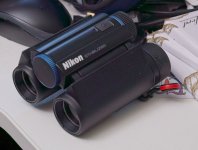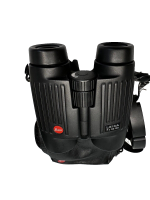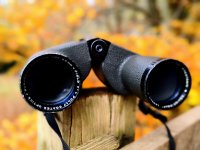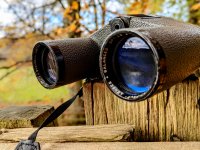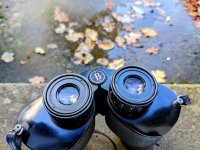
-
Welcome to BirdForum, the internet's largest birding community with thousands of members from all over the world. The forums are dedicated to wild birds, birding, binoculars and equipment and all that goes with it.
Please register for an account to take part in the discussions in the forum, post your pictures in the gallery and more.
You are using an out of date browser. It may not display this or other websites correctly.
You should upgrade or use an alternative browser.
You should upgrade or use an alternative browser.
Which binocular(s) did you use today? (1 Viewer)
- Thread starter Binocollector
- Start date
More options
Who Replied?Pinewood
New York correspondent

Hello,
Today, I decided to use my Zeiss 8x40 Victory I binocular, which I bought about 21 years ago, and was my first modern high quality glass. It is almost the same size as my Zeiss 8x32 SF, but rather heavier. This binocular was much maligned when introduced. There were objections to its smell, how the neck strap was attached, the focussing was anti-clockwise to infinity, its glare control could be better and it had insufficient suppression of chromatic aberrations.
Yes, I could perceive colour fringing under extremely unfavourable conditions, but I never found that a problem in use. I am sure that examining the image with a booster might have shown chromatic aberrations. The smell has disappeared and I never found the neck strap attachments problematic. I found the image to be bright and contrasty. With a 7.7º FOV, and a very smooth focussing, it gives a very comfortable view. Shortly after purchase, I settled on 8x32 binoculars for most bird watching.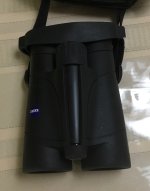
Today, this binocular helped me see:
American robins
white throat sparrows
blue jays
mallards
northern shovellers
hooded mergansers
American black duck
mourning doves
house finches
American crows
a fox sparrow
tufted titmice and
a downy woodpecker.
Stay safe,
Arthur
Today, I decided to use my Zeiss 8x40 Victory I binocular, which I bought about 21 years ago, and was my first modern high quality glass. It is almost the same size as my Zeiss 8x32 SF, but rather heavier. This binocular was much maligned when introduced. There were objections to its smell, how the neck strap was attached, the focussing was anti-clockwise to infinity, its glare control could be better and it had insufficient suppression of chromatic aberrations.
Yes, I could perceive colour fringing under extremely unfavourable conditions, but I never found that a problem in use. I am sure that examining the image with a booster might have shown chromatic aberrations. The smell has disappeared and I never found the neck strap attachments problematic. I found the image to be bright and contrasty. With a 7.7º FOV, and a very smooth focussing, it gives a very comfortable view. Shortly after purchase, I settled on 8x32 binoculars for most bird watching.

Today, this binocular helped me see:
American robins
white throat sparrows
blue jays
mallards
northern shovellers
hooded mergansers
American black duck
mourning doves
house finches
American crows
a fox sparrow
tufted titmice and
a downy woodpecker.
Stay safe,
Arthur
Last edited:
MiddleRiver
Well-known member

Refreshing to see such sanity!Hello,
Today, I decided to use my Zeiss 8x40 Victory I binocular, which I bought about 21 years ago, and was my first modern high quality glass. It almost the same size as my Zeiss 8x32 SF, but rather heavier. This binocular was much maligned when introduced. There were objections to its smell, how the neck strap was attached, the focussing was anti-clockwise to infinity, its glare control could be better and it had insufficient suppression of chromatic aberrations.
Yes, I could perceive colour fringing under extremely unfavourable conditions, but I never found that a problem in use. I am sure that examining the image with a booster might have shown chromatic aberrations. The smell has disappeared and I never found the neck strap attachments problematic. I found the image to be bright and contrasty. With a 7.7º FOV, and a very smooth focussing, it gives a very comfortable view. Shortly after purchase, I settled on 8x32 binoculars for most bird watching.View attachment 1545839
Today, this binocular helped me see:
American robins
white throat sparrows
blue jays
mallards
northern shovellers
hooded mergansers
American black duck
mourning doves
American crows
a fox sparrow
tufted titmice and
a downy woodpecker.
Stay safe,
Arthur
(and birding)
Binocollector
Well-known member

A current favourite - probably my smallest wide angle 8x30 porro. Not sure who made them, they carry no J-B or J-E-# and were sold under various names but they seem to be the usual Japanese porro design from the 70's probably.
Nice large sweetspot and sharpness in the center competes with the best of my modern roofs.
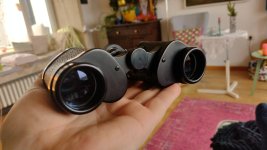
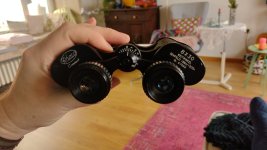
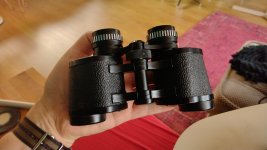
Nice large sweetspot and sharpness in the center competes with the best of my modern roofs.



edwincjones
Well-known member
which one did I use today? -- just depends on my needs, whats, whims
edj
edj
Pinewood
New York correspondent

Hello,
Today, I used my Zeiss 7x42 ClassiC. This binocular is the last iteration of a long line of binoculars, starting with the Hensoldt 7x42 "nachtglas," or night glass. The latter was a roof prism binocular but over the decades, the FOV was improved, lens coatings were applied and phase coating introduced. Some years ago, Zeiss introduced a 7x45 "night owl," which was front heavy, so the 7x42 Dilly was reintroduced as the ClassiC. Mine was made close to the end of the run. Its long body indicates a long focal length objective, minimising chromatic aberrations and it has an FOV of 150m at 1000m. It does not have internal focussing, so close focus is not what many would desire and I would not want to drop it into a puddle. The length might make it seem ungainly but it allows alternative ways of holding it steady.
I took it out this morning in overcast weather with showers, when birdlife seemed to be at a minimum. However I did see
blue jays,
male and female northern cardinals
male and female mallards
male and female hooded mergansers
an American black duck
white throat sparrows
mourning doves
downy woodpeckers and
male and female house finches.
Because of its easy to steady 7x power and its 42mm objective, this ClassiC is good binocular for finding planets in the twilight. I even used it find Venus in daylight.
Stay safe,
Arthur
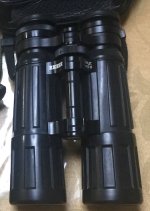
Today, I used my Zeiss 7x42 ClassiC. This binocular is the last iteration of a long line of binoculars, starting with the Hensoldt 7x42 "nachtglas," or night glass. The latter was a roof prism binocular but over the decades, the FOV was improved, lens coatings were applied and phase coating introduced. Some years ago, Zeiss introduced a 7x45 "night owl," which was front heavy, so the 7x42 Dilly was reintroduced as the ClassiC. Mine was made close to the end of the run. Its long body indicates a long focal length objective, minimising chromatic aberrations and it has an FOV of 150m at 1000m. It does not have internal focussing, so close focus is not what many would desire and I would not want to drop it into a puddle. The length might make it seem ungainly but it allows alternative ways of holding it steady.
I took it out this morning in overcast weather with showers, when birdlife seemed to be at a minimum. However I did see
blue jays,
male and female northern cardinals
male and female mallards
male and female hooded mergansers
an American black duck
white throat sparrows
mourning doves
downy woodpeckers and
male and female house finches.
Because of its easy to steady 7x power and its 42mm objective, this ClassiC is good binocular for finding planets in the twilight. I even used it find Venus in daylight.
Stay safe,
Arthur

Last edited:
Binocollector
Well-known member

@Pinewood
Awesome bino! An aunt of mine has an old Hensoldt 8x56 Dialyt. Fantastic glass even today despite the old coatings. (I better not tell her how much it might be worth or she won't use it anymore and that would be a shame.)
Since you mentioned the long focal length and minimizing CA. I have two old Japanese made 7x50s with AK-prisms and to my eyes they have zero false color even at the edges. And they are some of the few older binos I own that have enough eye-relief for me to use with glasses.
Awesome bino! An aunt of mine has an old Hensoldt 8x56 Dialyt. Fantastic glass even today despite the old coatings. (I better not tell her how much it might be worth or she won't use it anymore and that would be a shame.)
Since you mentioned the long focal length and minimizing CA. I have two old Japanese made 7x50s with AK-prisms and to my eyes they have zero false color even at the edges. And they are some of the few older binos I own that have enough eye-relief for me to use with glasses.
Pinewood
New York correspondent

Hello,
Today, I used a Bauch & Lomb 8x30 Zephyr. The binoculqr looks like an older B&L 8x30, which I had previously posted. This one was produced in 1951, with coated optics and lighter material. Like the other B&L, it is not eyeglass friendly, but I can use it, at least in daylight, as my myopia has been reduced with age and my astigmatism is not a problem in daylight. I need not write that this glass is very outdated but I still managed to see and identify
Mallards,
Northern shovellers,
Hooded Mergansers,
A male wood duck,
A great blue heron,
Mourning doves,
A Cooper hawk,
A male northern cardinal,
Blue jays,
White throat sparrows and
A female downy woodpecker.
I own three B&L 8x30 binoculars: this Zephyr, a pre WWII uncoated one and one from 1940 which must have had some elements coated after WWII.
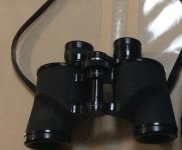
Stay safe,
Arthur
Today, I used a Bauch & Lomb 8x30 Zephyr. The binoculqr looks like an older B&L 8x30, which I had previously posted. This one was produced in 1951, with coated optics and lighter material. Like the other B&L, it is not eyeglass friendly, but I can use it, at least in daylight, as my myopia has been reduced with age and my astigmatism is not a problem in daylight. I need not write that this glass is very outdated but I still managed to see and identify
Mallards,
Northern shovellers,
Hooded Mergansers,
A male wood duck,
A great blue heron,
Mourning doves,
A Cooper hawk,
A male northern cardinal,
Blue jays,
White throat sparrows and
A female downy woodpecker.
I own three B&L 8x30 binoculars: this Zephyr, a pre WWII uncoated one and one from 1940 which must have had some elements coated after WWII.

Stay safe,
Arthur
Last edited:
Thotmosis
Well-known member

This beautiful little 6x24 Porro from the former USSR arrived yesterday. Huge FOV, yellow cast, sharp with nice contrast.
It‘s in a very good condition, especially considering it‘s age. The seller told me he bought it 40 years ago, used it a only few times and then it was in stored on the attic. The purple coating reminds me my Zeiss 15x60.
(Copyright pictures by the seller.)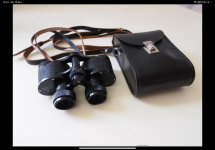
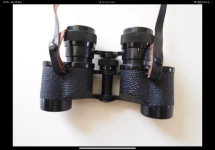
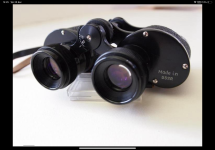
It‘s in a very good condition, especially considering it‘s age. The seller told me he bought it 40 years ago, used it a only few times and then it was in stored on the attic. The purple coating reminds me my Zeiss 15x60.
(Copyright pictures by the seller.)



Thotmosis
Well-known member

Attick treasure 😜Great condition
Pinewood
New York correspondent

Hello,
Although it was overcast, I decided to use my Bausch & Lomb 7x35 Zephyr. Mine was made in 1959, which would be near the end of the run of American production of this model. The 7x35 Zephyr was probably the most popular of the product line. A rarer binocular is the 9x35 Zephyr, which very similar. Mine has coated optics but it is still lacking ample eye relief for those who wear glasses but I can focus this to infinity.I did manage to see:
blue jays.
an American robin,
mourning doves,
white throat sparrows,
red belly woodpecker, male,
American crows,
A northern mockingbird, on West 81st Street,
mallards
Northern shovellers,
American black ducks,
hooded mergansers,
American coots,
pie-billed grebes,
and buffleheads.
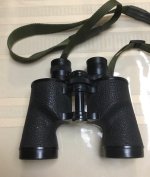
Stay safe,
Arthur
Although it was overcast, I decided to use my Bausch & Lomb 7x35 Zephyr. Mine was made in 1959, which would be near the end of the run of American production of this model. The 7x35 Zephyr was probably the most popular of the product line. A rarer binocular is the 9x35 Zephyr, which very similar. Mine has coated optics but it is still lacking ample eye relief for those who wear glasses but I can focus this to infinity.I did manage to see:
blue jays.
an American robin,
mourning doves,
white throat sparrows,
red belly woodpecker, male,
American crows,
A northern mockingbird, on West 81st Street,
mallards
Northern shovellers,
American black ducks,
hooded mergansers,
American coots,
pie-billed grebes,
and buffleheads.

Stay safe,
Arthur
Binocollector
Well-known member

Congrats! It's a lovely little bino, isn't it? Yours is in better condition than mine. Strange that it doesn't have the serial number with the manufacturing date on it. Mine's from 1978. I'm not sure when they were discontinued. But sometime in the 80's I think they changed the coatings and they no longer had the purple tint.This beautiful little 6x24 Porro from the former USSR arrived yesterday.
Thotmosis
Well-known member

Thanks Philipp. Yes it is a lovely little bino and more useful then i had thought. I found that it works good side by side a higher magnification bino, e.g. 12x50.Congrats! It's a lovely little bino, isn't it? Yours is in better condition than mine. Strange that it doesn't have the serial number with the manufacturing date on it. Mine's from 1978. I'm not sure when they were discontinued. But sometime in the 80's I think they changed the coatings and they no longer had the purple tint.
There is a serial number (see picture) but no manufacturing date.
Wasabrot
Well-known member

The first two numbers are the manufacturing date. It was made in 1970.Thanks Philipp. Yes it is a lovely little bino and more useful then i had thought. I found that it works good side by side a higher magnification bino, e.g. 12x50.
There is a serial number (see picture) but no manufacturing date.
Similar threads
- Replies
- 14
- Views
- 719
Users who are viewing this thread
Total: 2 (members: 0, guests: 2)




